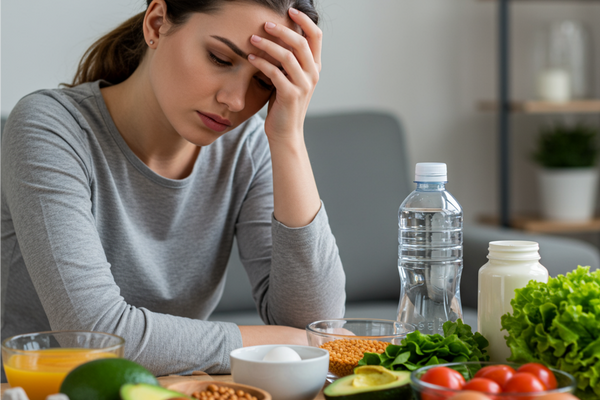Common Challenges When Starting the Keto Diet
by Sarath Veettil

The keto diet, known for its promise of weight loss and improved health, has gained significant popularity. However, beginners often face several challenges when starting this high-fat, low-carb lifestyle. These common struggles can be discouraging, but by understanding and preparing for them, such as knowing the foods to avoid on the keto diet for beginners you can set yourself up for success. In this blog, we'll explore five of the most common challenges people encounter and how to overcome them.
1. The Keto Flu
What It Is:
One of the most common keto diet challenges for beginners is the so-called "keto flu." This set of flu-like symptoms—such as headaches, fatigue, dizziness, and nausea—typically occurs in the first few days of switching to a keto diet. It happens as your body adapts to burning fat for fuel instead of carbohydrates.
Why It Happens:
The keto flu is a result of your body adjusting to a drastic reduction in carbs. This sudden drop can lead to an electrolyte imbalance, dehydration, and the loss of sodium, potassium, and magnesium.
How to Overcome It:
To ease the transition, focus on staying hydrated and replenishing your electrolytes. Drink plenty of water, and consider supplementing with magnesium and potassium. Eating keto-friendly, salt-rich foods, like avocados and leafy greens, can also help manage symptoms.
2. Finding Keto-Friendly Foods
What It Is:
At first, finding keto-friendly foods can be tricky. Traditional meals are often carb-heavy, and dining out or shopping for ingredients can feel overwhelming when you're trying to stick to a strict low-carb, high-fat plan.
Why It Happens:
Many beginners struggle to identify suitable foods at grocery stores or restaurants. The temptation to indulge in high-carb options is everywhere, making it harder to stay on track.
How to Overcome It:
Start by stocking up on keto essentials like healthy fats (avocados, olive oil), proteins (eggs, meat, tofu), and low-carb vegetables (spinach, zucchini, broccoli). When dining out, look for grilled meats, salads, or ask for substitutions (e.g., swap rice for cauliflower rice). Many stores now offer keto-friendly products, so keep an eye out for these options.
3. Tracking Macros and Calories
What It Is:
A critical aspect of the keto diet is tracking your macronutrients—fat, protein, and carbs—to maintain the proper balance. This can be a challenge, especially for those new to the diet.
Why It Happens:
Getting the right ratios of fat, protein, and carbs can be confusing. Many beginners find it difficult to calculate their macros or may inadvertently consume too many carbs or too little fat.
How to Overcome It:
Use tools like macro calculators and food tracking apps (MyFitnessPal, Carb Manager) to easily track your meals. These apps can help you stay on top of your macronutrient ratios and ensure you're staying within the recommended limits for keto success.
4. Dealing with Social Situations
What It Is:
Social events—such as family gatherings, dining out, or parties—can be challenging when you’re following a keto diet. It can be hard to avoid carb-heavy foods, and social pressure can make it tempting to indulge.
Why It Happens:
During social occasions, it’s easy to give in to the temptation of pizza, cake, or other carb-rich dishes, making it difficult to stay true to your keto plan.
How to Overcome It:
Don’t hesitate to bring your own keto-friendly dish to gatherings or politely decline food that doesn’t align with your diet. At restaurants, ask for low-carb substitutions. Focus on socializing and enjoy the company, rather than feeling stressed about food.
5. Overcoming Cravings
What It Is:
Cravings for sugar or carbs are among the most frustrating keto diet challenges for beginners. After cutting out sugar and refined carbs, many people experience strong cravings, particularly in the initial stages of the diet.
Why It Happens:
Sugar cravings can be intense, especially for those who have been accustomed to a high-carb, sugary diet. Emotional eating and stress can also trigger these cravings.
How to Overcome It:
The best way to manage cravings is to stay committed and ride them out. Substitute cravings with keto-friendly snacks like cheese, nuts, or dark chocolate. Over time, as your body becomes more accustomed to burning fat, these cravings will diminish.
Conclusion
Starting the keto diet can be challenging, but don’t let the keto diet challenges or common keto struggles discourage you. By being prepared for the obstacles that come your way—like keto flu, food finding, tracking macros, social situations, and cravings—you’ll be better equipped to stay on track. Remember, persistence is key, and the rewards of improved health, weight loss, and increased energy are well worth the effort.
If you're just starting out, don't hesitate to reach out for personalized meal plans or support. The keto journey can be tough, but it’s incredibly rewarding once you find your rhythm.
FAQs About Common Keto Diet Challenges
What causes the keto flu, and how long does it last?
The keto flu is caused by your body adapting to a low-carb, high-fat diet. As your body switches from burning carbohydrates to fat for energy, it can lead to symptoms like fatigue, dizziness, and headaches. Typically, the keto flu lasts from a few days to a week, but staying hydrated and balancing electrolytes can ease symptoms.
Can I eat fruit on the keto diet?
While most fruits are high in sugar and carbs, you can enjoy small portions of low-carb fruits like berries (strawberries, blueberries, raspberries) in moderation. Always monitor your portion sizes to ensure you don’t exceed your carb limits and stay within your ketogenic goals.
Is the keto diet safe for everyone?
The keto diet is generally safe for most people, but it may not be suitable for individuals with certain health conditions, such as liver or kidney disease. Always consult your doctor before starting any restrictive diet, especially if you have underlying health concerns or take medications.
How do I avoid cravings while on the keto diet?
Cravings are common when starting the keto diet, but they can be managed by ensuring you're eating enough healthy fats and protein. Consuming keto-friendly snacks like nuts, cheese, or avocado can help satisfy cravings. Over time, your body will adjust, and cravings should decrease.
Can I drink alcohol on the keto diet?
Alcohol is allowed on the keto diet in moderation, but some alcoholic beverages can be high in carbs, such as beer and sugary cocktails. Opt for low-carb drinks like dry wine or spirits mixed with sugar-free mixers. Always be mindful of your alcohol consumption, as it can impact ketosis.




